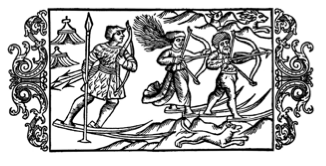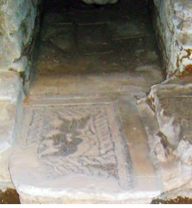Part II. The Hansa Lands and France
Chapter 36. Skis and a Gieres [November 20, 1347]
Cultural Explanations
 |
Part II. The Hansa Lands and France Chapter 36. Skis and a Gieres [November 20, 1347] Cultural Explanations |
|
|
In this chapter Bávlos teaches his new friends how to ski and heads south to Limoges. | ||
| Girard, Guillaume, Nieiddash, Bávlos, Monastery of St. Martial, Ruto, St. Martial |
In this chapter, Bávlos teaches his friends to ski and travels with them to the Monastery of St. Martial at Limoges. There he meets the young Pierre Roger, nephew to the pope.
 |
Woodcut showing Sámi hunting from Bishop Olaus Magnus's History of the Northern Peoples (1555). Olaus completed his work in exile in Venice; the Italian artist who made this image clearly had no inkling what skis looked like, since they were unknown in southern Europe until the nineteenth century. Image courtesy this website, containing free downloads of all the illustrations in Olaus's great work. Click HERE to go to original site. |
Skiing did not become commonplace in France until the late nineteenth century. My story of Bávlos teaching the skill to French clerics is pure fiction. Nonetheless, it is certainly true that Sámi—as well as other Scandinavians—took advantage of the winter as an ideal time to make long distance travel over land. Rivers and lakes, now frozen, became prime arteries for transportation, and heavy loads could be transported by sleigh over a smooth and level surface. For Sámi who travelled with reindeer, it was important to take routes that crossed lands with loose, light snow that the reindeer could paw up in pursuit of grazing. If the snow became heavy, packed, or ice-bound, it could prove dire for one's reindeer and the success of one's journey.
 |
| Patch of mosaic from the original crypt of St. Martial: virtually all that remains of the once great monastery of St. Martial at Limoges. Image by Sjwells53, courtesy Wikimedia. |
The monastery of St. Martial at Limoges was one of the wealthiest institutions of its kind in medieval France. Guillaume de Chanac was a member of the monastery, but spent most of his career away from the monastery, teaching in Paris, and eventually advising two popes at Avignon. For upwardly mobile clerics like Guillaume, the home monastery conferred a kind of validation on one's career but seldom proved a longterm residence for any extended period. A Benedictine house, the monastery at Limoges possessed the relics of St. Martial, a martyr-bishop of great importance to the early history of Christianity in France. Limoges lay on one of the main pilgrimage routes to both Santiago de Compostela and Rome, and was a favorite stopping place for travellers. The monastery was destroyed in the nineteenth century, although the crypt containing the relics of St. Martial was rediscovered in the mid-1960s. I base my descriptions of the monastery on medieval accounts of the site, as well as insights provided by Raymond Oursel in his magisterial work Routes romanes (ISBN 2-7369-0005-7). When so many great medieval structures like Notre Dame de Paris survive (in some form) into the current era, it is easy to imagine that the sights that would have greeted a fourteenth-century pilgrim are still amply in evidence in Central Europe. Such is not always the case, as the sad absence of this once great abbey demonstrates.
Pierre Roger de Beaufort (c. 1336-78) was a nobleman raised at the estate of Maumont, in the diocese of Limoges. He was the nephew of Pierre Roger (1291-1352), Pope Clement VI. In 1348, at the age of nineteen, Pierre the younger was abruptly named cardinal by his uncle. He subsequently traveled to Italy, where he studied canon law for a time and became a theologian. In 1370, he was elected pope, receiving holy orders, the status of bishop, and the status of pope all at once. He took the name of Pope Gregory XI. Although he remained at Avignon for most of his years as pope, he eventually heeded the call of St.Caterina da Siena to come to Rome in 1377, where he died one year later, in 1378.
Pierre Roger the elder (1291-1352) was also a Benedictine monk. He was elected pope Clement VI in 1342. Wealthy and worldly beyond even the rather excessive norms of his day, he became known as le Magnifique ("The Magnificent"). His lavish dinners and entertainments became the stuff of legends. In 1348, he agreed to purchase the city of Avignon from Queen Joanna I of Naples to maintain as the permanent papal seat. He instituted the second grand Jubilee year in 1350, attracting pilgrims from throughout Europe to Rome. St. Birgitta and her daughter Katarina were two of the pilgrims who traveled to Rome on that occasion. Prior to the pope's decree, Jubilee years were held only once a century. The decision to decree a Jubilee once every fifty years brought the custom more in line with biblical precedents and ensured that many people would be able to partake of a Jubilee year once in their lives.
When the Plague arrived in Marseille on November 1, 1337, the disease spread with amazing speed and ferocity along major trade routes throughout the south of France. Clement sequestered himself in the papal apartments and kept two fires burning at all times in order to stave off the disease. He survived the Plague year but died soon after, in 1352. Although my story about Clement being sent a reindeer is fictional, it is true that Clement had a set of rooms in his apartments painted with hunting scenes and images of wildlife. One of these rooms is called the "chambre du cerf" on account of its prominent depiction of a deer.
On hearing about the rampaging epidemic, Bávlos remembers his dream about the Sámi demon of disease, Ruto. On his drum, he places Ruto along the edge (where he often appears in historical drumheads). He also creates an image of St. Martial as a bishop flanked by two loaves, a reference to his role in Christ's miracle of the loaves and fishes.